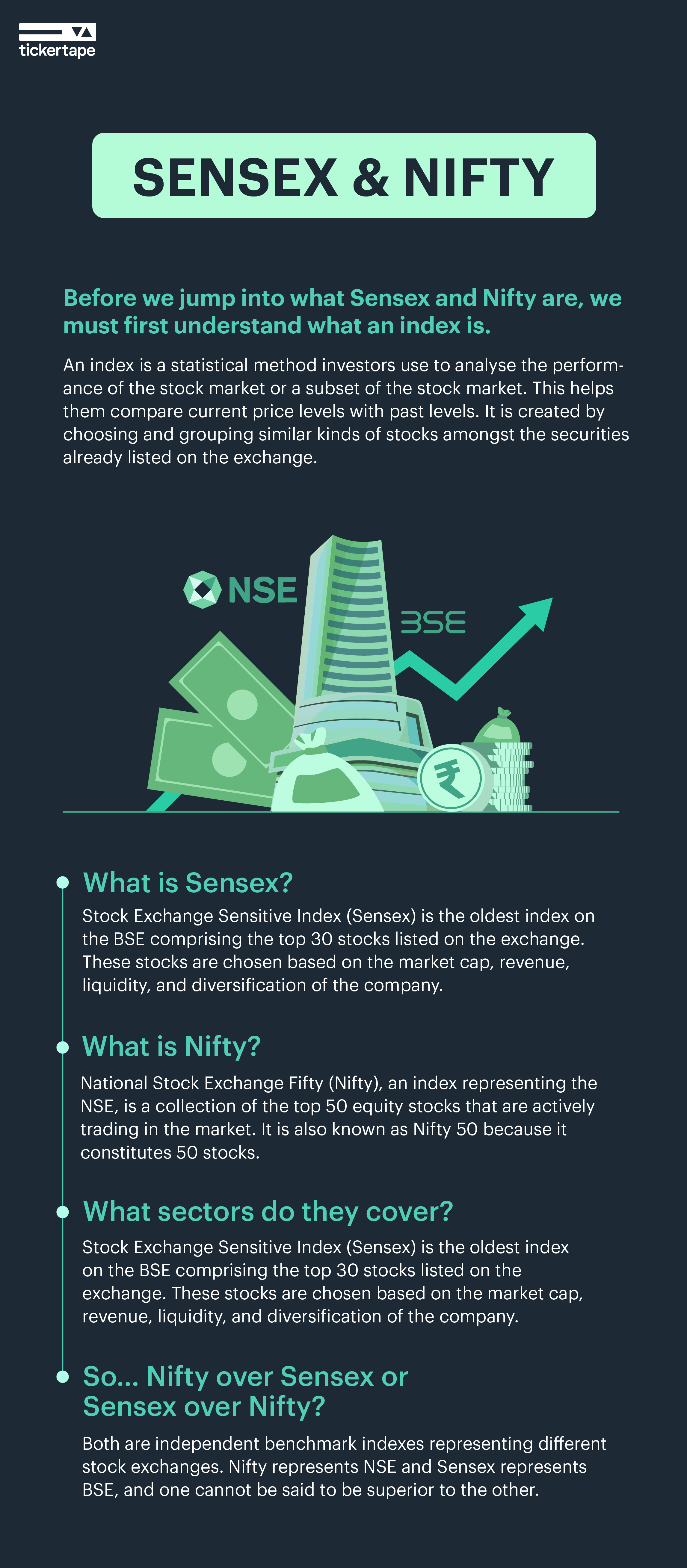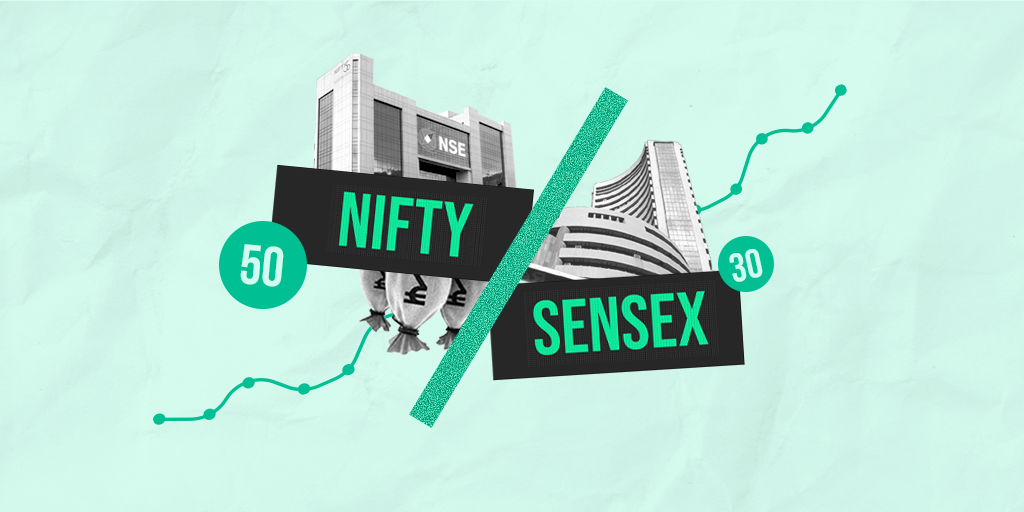Last Updated on May 24, 2022 by Aradhana Gotur
Have you heard of Sensex and Nifty? Or are they foreign to you? Well, these are two of the most important and popular indices representing the country’s stock market. They not only help measure the performance of the stock market but also the broader economy.
Let’s learn more about Sensex and Nifty – how they are calculated and the ways in which they differ from each other.
Table of Contents
What is a stock market index? Why is it important?
An index is a statistical method with which investors compare the current price of stocks with the past price to analyse market performance. You can also measure the performance of your investments against a market index.
How is an index created? To create an index, a few of the similar stocks are chosen among the securities that are listed on the exchange. The stocks are selected based on the market cap, industry or company size and then grouped together.
Any change happening in the underlying stock prices will impact the overall index value. This means, if the price of chosen securities rises, the overall value of the index will rise as well.
If you are wondering why stock indices are important then here is your answer. You can use these indices to study the market and decide which stock to invest in after identifying the trend patterns. Thus, indices act as a standard representing the market condition. The importance of indices are listed below:
- It represents the entire stock market.
- It acts as a benchmark for stock picking.
- It helps in assessing a stock by comparing peers.
- It helps gauge the mood of the investors.
- If you don’t wish to research and choose stocks, you can invest in indices like Sensex and Nifty and earn as per their performance.
What is Sensex?
Sensex is the oldest index of India. Its full form is Stock Exchange Sensitive Index. This term was coined by a market analyst named Mr Deepak Mohoni. Sensex is an index on the BSE comprising the top 30 stocks that are listed on the exchange. These 30 stocks are chosen based on the market cap, revenue, liquidity, and diversification of the company.
How is Sensex calculated?
It is a value-weighted index, wherein the market cap of each stock is multiplied with a free-float factor after which, you arrive at the modified market cap of the stocks. Here’s how it is calculated:
- First, the market cap of all 30 companies is calculated.
- Then, the free-float market cap of the companies is estimated and added together to get the total free-float market cap.
- Now, these are put in the Sensex formula to determine the value of Sensex.
Note:
Sensex formula = (Free float market capitalisation of 30 companies / Base market capitalisation) x Base value of the index)

What is Nifty?
Nifty is a benchmark index as well. However, instead of BSE, it represents the NSE. The Nifty is a combination of two words, that is National Stock Exchange Fifty. It is a collection of the top performing 50 equity stocks from 24 different sectors that are actively trading in the market. It is also known as Nifty 50 for this reason.
Nifty is owned and managed by India Index Service & Products Limited (IISL). It follows the trends and patterns of the blue-chip stocks that belong to the largest companies with high liquidity in India. To be a part of Nifty, the company’s float-adjusted market cap should be twice of current smallest index composition. They should all be Indian and listed on NSE.
How is Nifty calculated?
Nifty is calculated based on using the free-float market cap-weighted method. The index price reflects the total market value of all 50 stocks relative to the base. The calculation of Nifty index value involves the following formulas:
- Market Cap = Current market price x Outstanding shares
- Free Float Market Capitalisation = Shares outstanding x Price x Investable Weight Factors (IWF)
- Index Value = (Current Market Value / Base Market Capital) x Nifty Base Index Value
- Investable weight factors (IWF) are the units of floating stock in terms of a number that are available for trading and are not held by the entities having strategic interest in a company.
Note:
The Nifty base index value is 1000.
Let us now differentiate between the two.
Difference between Sensex and Nifty
The following table lists the major differences between Sensex and Nifty.
| Parameter | Sensex | Nifty |
| Full form | Stock Exchange Sensitive Index | National Stock Exchange Fifty |
| Ownership | BSE | NSE’s subsidiary: Index and Services and Products Limited (IISL) |
| Base number | 100 | 1000 |
| Base period | 1978-79 | 3 November 1995 |
| Number of sectors covered | 13 | 24 |
| Foreign exchanges | It trades on EUREX and stock exchanges of Brazil, Russia, China, and South Africa (BRCS) nations | It trades on the Singapore Stock Exchange (SGX) and Chicago Mercantile Exchange (CME) |
The Nifty has a broader spectrum in terms of trade volume i.e., more active buyers and sellers in the market than Sensex. It also has higher liquidity and hence can be easily converted into ready cash. Many stocks that are traded on Nifty are traded on Sensex too.
FAQs
Is Nifty better than Sensex?
Nifty represents NSE and Sensex represents BSE. Both are independent benchmark indices, and one cannot be said to be superior to the other.
Are Nifty and Nifty50 the same?
Yes, Nifty50 is another term for Nifty.
What historical data is available for Nifty50?
The data for Nifty50 is available from 3 July 1990.
Who maintains the Sensex?
The Index Cell of the exchange does the day-to-day maintenance of the index within the broad index policy framework set by the Index Committee.
What are some of the sectors in Nifty50?
The sectors of Nifty50 include Automobile, banking, cement, chemical, construction, consumer goods, energy, financial services, IT, infrastructure, metals, pharmaceuticals, telecommunications, etc.
- List of Top Overnight Mutual Funds in India for 2025 - Apr 21, 2025
- Income Funds – Meaning, Types & What to Watch Out For - Apr 21, 2025
- Hedge Funds in India: Types, Features, and Benefits - Apr 15, 2025




